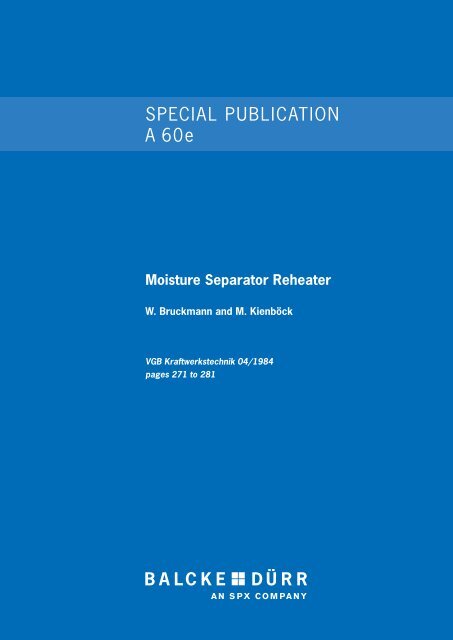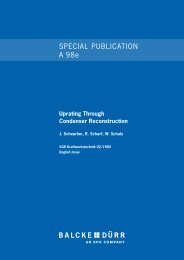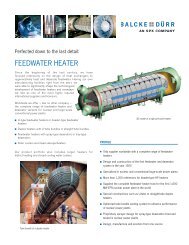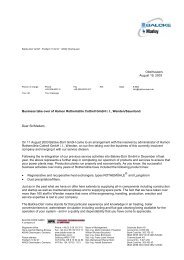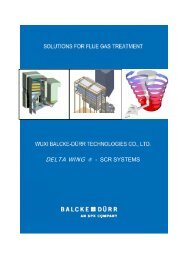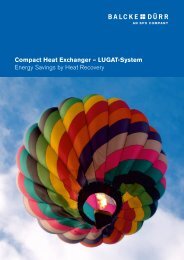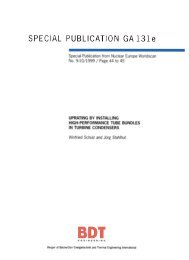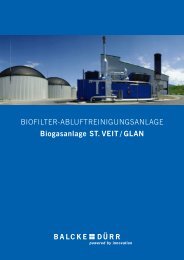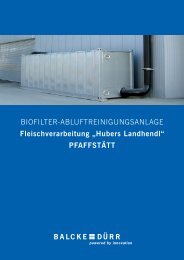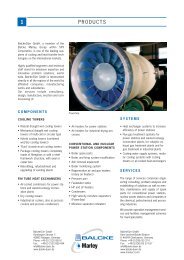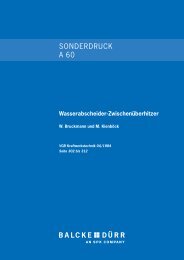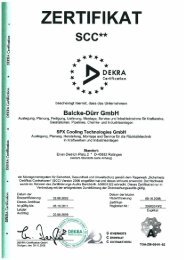Moisture Separator Reheater - Balcke-Dürr Energietechnik Gmbh
Moisture Separator Reheater - Balcke-Dürr Energietechnik Gmbh
Moisture Separator Reheater - Balcke-Dürr Energietechnik Gmbh
Create successful ePaper yourself
Turn your PDF publications into a flip-book with our unique Google optimized e-Paper software.
Special publication<br />
a 60e<br />
<strong>Moisture</strong> <strong>Separator</strong> <strong>Reheater</strong><br />
W. Bruckmann and M. Kienböck<br />
VGB Kraftwerkstechnik 04/1984<br />
pages 271 to 281
coMpReHenSi V e coMpetence in SeRVice<br />
anD Heat e XcH anG eRS<br />
More than 125 years of prod-<br />
uct competence, the innovative<br />
force of our inter national teams<br />
of ex perts as well as constant<br />
re search and development are<br />
the basis of our global power<br />
strategy.<br />
Advantages to our customers:<br />
Complete solutions and ser-<br />
vices from one single source –<br />
quick, flexible and efficient.<br />
Count on us and benefit from<br />
our product and service com-<br />
petence.<br />
RANGE OF PRODUCTS AND SERVICES<br />
Power plant components<br />
Development, design, manufacture,<br />
erection and commissioning of:<br />
• Surface steam condensers<br />
• Feedwater heaters<br />
• Deaerators/feedwater tanks<br />
• <strong>Moisture</strong> separator reheaters<br />
• poWeRSep ® high velocity<br />
separators<br />
• poWeRVane ® chevron type<br />
separators<br />
Air and flue gas systems<br />
Development, design, manufacture,<br />
erection and commissioning of:<br />
• Regenerative air and gas<br />
heaters of the RotHe MÜHle ®<br />
and Ljungström types<br />
• Air pollution control equipment<br />
RotHeMÜHle ® design<br />
• bi-coRona ® electrostatic<br />
precipitators<br />
• Bag filters<br />
• Delta WinG ® static gas mixers<br />
for use in DeNOx systems and<br />
optimisation of dust collection<br />
efficiency in eSps<br />
Boiler services and general<br />
power plant services<br />
• Engineering<br />
• Manufacture<br />
• Erection<br />
• Maintenance and upkeep<br />
• Spare parts<br />
• Provision and management of<br />
overhaul services<br />
• Boiler modernisation and<br />
modification<br />
• Replacement and modernisation<br />
of power plant components as<br />
well as air and flue gas systems
<strong>Moisture</strong> <strong>Separator</strong> <strong>Reheater</strong>s<br />
W. Bruckmann and M. Kienböck<br />
Abstract<br />
<strong>Moisture</strong> <strong>Separator</strong> <strong>Reheater</strong>s<br />
With the commencement of construction of<br />
light water reactors (LWRs) it became necessary,<br />
because of the steam condition to provide<br />
<strong>Moisture</strong> <strong>Separator</strong>s and <strong>Reheater</strong>s<br />
(MSRs) for saturated steam turbines. In a brief<br />
chronological summary the various stages of<br />
development are compared based on the designs<br />
and specific performance data and the<br />
advantages and disadvantages are contrasted.<br />
This paper describes cyclone separators and<br />
plate separators as well as plain tube reheaters<br />
and finned tube elements in many different arrangements.<br />
Kurzfassung<br />
Authors<br />
Wasserabscheider-<br />
Zwischenüberhitzer<br />
Mit dem Beginn des Baues von Leichtwasserreaktoren<br />
(LWR) entstand (aufgrund des<br />
Dampfzustandes) der Bedarf für Wasserabscheider<br />
und Zwischenüberhitzer (WAZÜ) für<br />
Sattdampfturbinen. In einem kurzen chronologischen<br />
Abriss werden die verschiedenen Entwicklungsstufen<br />
konstruktiv und mit ihren spezifischen<br />
Leistungsdaten gegenübergestellt<br />
und die Vor- und Nachteile herausgearbeitet.<br />
Es werden Zyklonabscheider und Prallplattenabscheider<br />
sowie Glattrohrüberhitzer und Rippenrohrkonstruktionen<br />
in jeweils verschiedenster<br />
Anordnung beschrieben.<br />
Dipl.-Ing. (FH) W. Bruckmann<br />
Dipl.-Ing. M. Kienböck<br />
<strong>Balcke</strong>-<strong>Dürr</strong> AG<br />
Ratingen/Germany<br />
Introduction<br />
<strong>Moisture</strong> separators and reheaters, referred to<br />
below as MSRs, are normally installed between<br />
the HP and the LP turbines in nuclear power<br />
plants to increase efficiency and to avoid damage<br />
to the LP turbine ( F i g u r e 1 ) .<br />
The MSRs cannot be bypassed owing to the<br />
fact that they are arranged between the HP<br />
and the LP turbines. This results in a direct<br />
influence on the availability of the turbosets.<br />
The load behaviour of the MSRs is determined<br />
directly by the turbines and as a result<br />
of possible intercept valve test cases and the<br />
switching on and off of the reheaters during<br />
operation, the MSRs are subjected to more<br />
complex operating conditions and greater<br />
load change speeds than most other heat exchangers<br />
in a power plant.<br />
From various publications [2 to 4] and unfortunately<br />
also from own experience we are familiar<br />
with damage to moisture separators and<br />
reheaters. Damage to the MSRs is taken note<br />
of and publicised to a greater extent than damage<br />
to other heat exchangers because of their<br />
direct influence on the availability of the<br />
whole plant. In a short chronological outline<br />
we would like to attempt to compare the various<br />
development stages with their specific<br />
output data and to show the advantages and<br />
Table 1. Types of moisture separators.<br />
Plant Type of separator Arrangement In<br />
operat.<br />
Obrigheim (old) Cyclone coarse<br />
separator with<br />
centrifugal main sepa-<br />
rator and fine separator<br />
Stade X<br />
Borssele/NL<br />
Mülheim-Kärlich<br />
Atucha/ARG<br />
Kalkar<br />
Brunsbüttel<br />
Unterweser<br />
Neckarwestheim<br />
Tullnerfeld/A<br />
Obrigheim (new)<br />
Gösgen-Däniken/CH<br />
Trillo/ES<br />
Philippsburg 2<br />
Grohnde<br />
Angra 2 and 3/BRA<br />
Cyclone separator<br />
with agglomerator<br />
connected upstream<br />
<strong>Moisture</strong> <strong>Separator</strong> <strong>Reheater</strong>s<br />
disadvantages. For obvious reasons we have<br />
limited the facts to the plants with which we<br />
are familiar in Germany and the plants which<br />
are influenced by the German market.<br />
Types of <strong>Moisture</strong> <strong>Separator</strong>s<br />
The separators which we have built or designed<br />
are listed in Ta b l e 1 and subdivided<br />
into cyclone separators and chevron type separators<br />
according to their operating characteristics.<br />
<strong>Separator</strong> systems from the USA which had<br />
originally been proven in small plants were<br />
installed in the Stade, Borssele and Atucha<br />
plants. In all three cases the high steam velocities<br />
during commissioning led to vibration<br />
damage and complete destruction of<br />
these internals. The axial cyclones which had<br />
previously only been provided for preliminary<br />
separation were improved by optimising<br />
the blades and connecting suction devices in<br />
series in order to enhance these 3 plants. In<br />
addition, agglomerating units [7] were installed<br />
in the feed lines: by increasing the size<br />
of fine spray droplets these units displace the<br />
droplet spectrum to such an extent that the<br />
separation process can be carried out with an<br />
economical pressure loss. After the conversion<br />
of these plants residual moisture values<br />
Vertical<br />
cyclone<br />
Arranged<br />
in the<br />
piping<br />
Plate separator Pyramid<br />
column<br />
Plate separator<br />
<strong>Separator</strong><br />
wall<br />
Star column<br />
X<br />
X<br />
X<br />
X<br />
X<br />
X<br />
X<br />
X<br />
Erec-<br />
ted<br />
X<br />
X<br />
X<br />
X<br />
X<br />
Under<br />
constr.<br />
X<br />
X<br />
Figure<br />
3<br />
4<br />
6<br />
7 and 8<br />
3
<strong>Moisture</strong> <strong>Separator</strong> <strong>Reheater</strong>s<br />
of < 0.5 % were measured downstream of the<br />
separator ( F i g u r e 2 ) .<br />
The Atucha ( F i g u r e 3 ) and Kalkar separators<br />
which are installed in the piping should<br />
be mentioned. The specific constructional<br />
volume of these separators is considerably<br />
less than that of separators installed in vessels.<br />
As you can see from Ta b l e 3 the specific<br />
constructional volume of Atucha, defined<br />
as m3 /MW, is only 1 ⁄ 10 of the constructional<br />
volume required for separators installed<br />
in vessels. This construction could not gain<br />
acceptance in Germany as a result of the pressure<br />
loss values and because the plate separators<br />
are given preference. At the moment developments<br />
[5] are being carried out in France<br />
in this direction whereby the separator is constructed<br />
as a multiple cyclone to reduce the<br />
pressure losses.<br />
4<br />
Primary circuit Secondary circuit<br />
Reactor<br />
Recirculation<br />
pump<br />
HP heater<br />
<strong>Moisture</strong> separator reheater<br />
HP turbine LP turbine Generator<br />
Steam generator<br />
Condenser<br />
Feedwater tank<br />
Feedwater pump<br />
LP heater Condensate pump<br />
Figure 1. Flow diagram of a nuclear power plant with<br />
pressurised water reactor.<br />
Table 2. Types of reheaters.<br />
Percentage of moisture<br />
at outlet separator y in %<br />
The disadvantages of the solution proposed<br />
here are that a motive steam flow of approx.<br />
10 % of the flow rate is required and that access<br />
and ease of inspection are poor compared<br />
to a single cyclone.<br />
Types of <strong>Reheater</strong>s<br />
1.0<br />
0.5<br />
The reheaters which we construct are vertical<br />
as opposed to the horizontal reheater arrangements<br />
applied elsewhere (USA, France). The<br />
condensate draining for the reheated steam<br />
which condenses in the pipes is simplified in<br />
the vertical construction compared with the<br />
horizontal construction as a result of the effects<br />
of gravity. A great deal of damage<br />
[2, 10] has occurred on the horizontally arranged<br />
MSRs as a result of a backflow of<br />
steam at reheater tubes under a low load and<br />
the subsequent subcooling of the condensate.<br />
Plant Bundle construction Tube No. of bundles<br />
per MSR<br />
Obrigheim (old) Header construction Plain tube 1 X<br />
Stade Header construction Plain tube 1 X<br />
Borssele/NL Header construction Plain tube 2 (2-stage) X<br />
From heat balance<br />
Derived from previous<br />
acceptance test measurements<br />
When utilising all tolerances<br />
0<br />
0 50 100 150<br />
Capacity in %<br />
Figure 2. Mean residual moisture, measurement in Stade (1973).<br />
The causes for this damage have been recognised<br />
in the meantime and proposals with regard<br />
to design and construction have been<br />
made in various publications [8, 10].<br />
Our calculations and operating experience in<br />
connection with the vertical reheater show<br />
that additional measures such as:<br />
− graduated orifices,<br />
− subdivision of bundles into several passes<br />
connected in series with a condensate discharge<br />
pipe after each pass,<br />
− bleeding off of motive steam<br />
are not required for the load cases known up<br />
to now.<br />
The reheaters which we have designed are<br />
listed in Ta b l e 2 . Header constructions<br />
and tubesheet constructions are used for the<br />
plain tube type ( F i g u r e 4 ) . Both constructions<br />
function in a similar way; the reheated<br />
In operat. Erected Under<br />
construct.<br />
Brunsbüttel Tubesheet construction Plain tube 1 X<br />
Unterweser<br />
Neckarwestheim<br />
Tullnerfeld/A<br />
Obrigheim (new)<br />
Tubesheet construction<br />
Tubesheet construction<br />
Tubesheet construction<br />
Tubesheet construction<br />
Plain tube<br />
Plain tube<br />
Plain tube<br />
Plain tube<br />
1<br />
1<br />
1<br />
1<br />
X<br />
X<br />
X<br />
X<br />
6<br />
6<br />
Unterweser (new) Tubesheet construction Plain tube 1 X<br />
Brunsbüttel (new) Tubesheet construction Plain tube 1 X<br />
Mülheim-Kärlich Tubesheet construction Fin tube 8 X<br />
Gösgen-Däniken/CH Tubesheet construction Fin tube 4 X 6<br />
Trillo/ES Tubesheet construction Fin tube 6 X<br />
Philippsburg 2 Tubesheet construction Fin tube 6 X 7 and 8<br />
Grohnde Tubesheet construction Fin tube 6 X<br />
Angra 2 and 3/BRA Tubesheet construction Fin tube 6 X<br />
Figure
22 000<br />
7<br />
3<br />
6<br />
Ø 3 200<br />
2<br />
Ø 4 500<br />
Drain pipe<br />
Figure 4. <strong>Moisture</strong> separator and reheater of the<br />
Unterweser Nuclear Power Plant.<br />
5<br />
1<br />
4<br />
1 Fine separator<br />
2 Coarse separator<br />
3 <strong>Reheater</strong><br />
4 Turbine steam inlet<br />
5 Turbine steam outlet<br />
6 Heating steam inlet<br />
7 Heating steam condensate outlet<br />
Condensate outlet nozzle<br />
7<br />
1<br />
2<br />
3<br />
4<br />
5<br />
Agglomerator<br />
6<br />
<strong>Moisture</strong> <strong>Separator</strong> <strong>Reheater</strong>s<br />
1 Agglomerator<br />
2 Manhole<br />
3 1st vortex generator<br />
4 1st drain<br />
5 2nd vortex generator<br />
6 2nd drain<br />
7 HP turbine<br />
8 <strong>Moisture</strong> separator tank<br />
Figure 3. <strong>Moisture</strong> separator of the Atucha Nuclear Power Plant.<br />
e finned<br />
e plain<br />
j;<br />
5.0<br />
2.0<br />
1.0<br />
0.5<br />
0.2<br />
0.1<br />
steam condenses in the tubes and is collected<br />
in the lower header or the lower duct and directed<br />
out of the vessel whilst the<br />
turbine steam flows mainly in longitudinal<br />
flow around the bundle and is reheated in the<br />
process.<br />
As a result of the simple and distinct construction,<br />
this type of reheater installed in 10 plants<br />
of which 8 are in operation has functioned<br />
with practically no defects apart from damage<br />
to the guide shell in Unterweser. All reheaters<br />
of the first generation with plain tubes<br />
achieved better heating values than guaranteed<br />
but also higher pressure losses compared<br />
to the design data.<br />
e finned<br />
e plain<br />
NU plain<br />
8<br />
j finned<br />
j plain<br />
NU finned<br />
(apparent)<br />
10<br />
RE comparison<br />
4 2 5 105 2 5 106 0.05<br />
Figure 5. Comparison of the performance figures of fin tube and<br />
plain tube arrangement.<br />
10 3<br />
NU<br />
10 2<br />
5
<strong>Moisture</strong> <strong>Separator</strong> <strong>Reheater</strong>s<br />
Table 3. Comparison of technical data.<br />
The plain tube construction was abandoned<br />
because of the limitation in the admissible<br />
overall height of the MSRs and the high pressure<br />
losses and various fin tube reheaters<br />
were designed. The geometry of the fin tubes<br />
calls for a diagonal initial flow to the fin tube<br />
bundle. Although the area of the fin tube<br />
bundle is smaller than that of the plain tube<br />
bundle due to the larger surface area, the specific<br />
constructional volume of the fin tube<br />
reheater is larger than that of plain tube bundles<br />
with a longitudinal flow due to the diagonal<br />
flow and also the initial and exit flow<br />
6<br />
Obrigheim (old)<br />
Stade<br />
Borssele<br />
Mülheim-Kärlich<br />
Kalkar<br />
Operat. time approx. in 10 4 h 10 8 7 – – 7 4 4 5 – 1 4 – – – – –<br />
Total pressure drop<br />
in % of inlet pressure<br />
Residual moisture<br />
in %<br />
Guaranteed<br />
Measured<br />
Guaranteed<br />
Measured<br />
Specific overall volume m 2 /MW<br />
Velocity in the<br />
main separator<br />
Specific overall volume m 2 /MW<br />
Terminal<br />
temp. difference<br />
11<br />
Section A - B<br />
moisture<br />
separator<br />
10<br />
2.0<br />
1.0<br />
6<br />
12<br />
0.8<br />
0.4<br />
8<br />
–<br />
–<br />
6<br />
–<br />
0.3<br />
–<br />
3<br />
–<br />
0.8<br />
–<br />
Atucha<br />
Brunsbüttel<br />
Unterweser<br />
Neckarwestheim<br />
cross-sections required as a result of this. The<br />
main advantage lies in the lower pressure<br />
loss. An evaluation of the thermal advantages<br />
and the advantages with regard to the flow<br />
has been attempted in Figure 5 [6]. An efficiency<br />
coefficient is formed as quotient from<br />
the transferred thermal efficiency and the<br />
pump output used (pressure loss); for the<br />
finned heat exchanger this is by a factor of<br />
1.4 – 1.5 greater than for a plain tube bundle<br />
in a Reynold’s number range between 10 4<br />
and 10 6 .<br />
2<br />
–<br />
0.7<br />
–<br />
6<br />
7<br />
0.8<br />
0.3<br />
6<br />
-<br />
0.8<br />
0.3<br />
6<br />
6<br />
0.8<br />
0.3<br />
0.2 0.2 0.14 0.2 0.08 0.02 0.2 0.24 0.2 0.2 0.2 0.24 0.19 0.2 0.2 0.2 0.25<br />
m/s 21 45.5 40 45.5 30.3 40 3.8 3.7 3.9 3.9 4.7 4.0 4.0 4.0 4.0 4.0 4.0<br />
Guaranteed<br />
Measured<br />
C D<br />
5<br />
4<br />
1<br />
2<br />
6<br />
3<br />
10<br />
7<br />
reheater<br />
0.16 0.2<br />
– 40<br />
25<br />
0.55<br />
2-st.<br />
–<br />
–<br />
Tullnerfeld<br />
6<br />
–<br />
0.8<br />
–<br />
0.26 – – 0.2 0.15 0.2 0.2 0.35 0.26 0.27 0.25 0.25 0.25 0.4<br />
28.5<br />
–<br />
1 <strong>Reheater</strong><br />
2 Fine separator wall<br />
3 Turbine steam inlet<br />
4 Turbine steam outlet<br />
5 Heating steam inlet<br />
6 Heating steam<br />
condensate outlet<br />
7 Coarse separator drain<br />
8 Fine separator drain channel<br />
9 Fine separator drain nozzle<br />
10 Vent nozzle to condensate<br />
collecting tank<br />
11 Manhole<br />
Section C - D<br />
A B<br />
8<br />
9<br />
Figure 6. <strong>Moisture</strong> separator and reheater in the<br />
Gösgen-Däniken Nuclear Power Plant. Figure 8. Installation of the reheater bundles.<br />
–<br />
–<br />
–<br />
–<br />
40<br />
40<br />
35<br />
32<br />
40<br />
32<br />
20<br />
–<br />
Obrigheim (new)<br />
6<br />
6<br />
0.3<br />
0.3<br />
35<br />
35<br />
Gösgen-Däniken<br />
6<br />
3<br />
0.8<br />
0.5<br />
30<br />
33<br />
Trillo<br />
4.5<br />
–<br />
0.5<br />
–<br />
40<br />
–<br />
Philippsburg 2<br />
Grohnde<br />
Angra 2 and 3<br />
Convoy<br />
Instead of being compact like a plain tube<br />
bundle the heating surface of the fin tube<br />
reheater is split up into individual bundles<br />
because a diagonal flow is required in each<br />
individual bundle: these bundles are arranged<br />
next to one another in ring form (F i g u r e s<br />
7 , 8 and 9 show the installation of the reheater<br />
bundles in the Grohnde plant) or as a<br />
wall (Gösgen-Däniken F i g u r e 6 ).<br />
The required seals between the single tube<br />
bundles and to the vessel are considerably<br />
more costly and more complex than in the<br />
case of a compact bundle owing to intermittent<br />
operating cases and the subsequent temperature<br />
differences and relative motions.<br />
4<br />
–<br />
0.5<br />
–<br />
40<br />
–<br />
4<br />
–<br />
0.5<br />
–<br />
40<br />
–<br />
4<br />
–<br />
0.5<br />
–<br />
40<br />
–<br />
4<br />
–<br />
0.5<br />
–<br />
15<br />
–
Figure 7. <strong>Moisture</strong> separator and reheater in the Grohnde Nuclear Power Plant.<br />
<strong>Moisture</strong> <strong>Separator</strong> <strong>Reheater</strong>s<br />
7
<strong>Moisture</strong> <strong>Separator</strong> <strong>Reheater</strong>s<br />
Figure 9. <strong>Moisture</strong> separator and reheater of the Convoy Nuclear Power Plants.<br />
8
Figure 10. <strong>Moisture</strong> separator and reheater in the<br />
Obrigheim Nuclear Power Plant.<br />
Comparison of the Technical Data<br />
The technical data and the values measured<br />
on the different constructions in operation are<br />
compared in Ta b l e 3 . In summary it can be<br />
said that within the scope of the measuring<br />
accuracy both the cyclone separator with agglomerating<br />
unit and the plate separator yield<br />
a comparable amount of residual moisture.<br />
The advantage of the cyclone lies in the fact<br />
that it is insensitive to local streaks of water,<br />
unbalanced charging and intermittent load<br />
cases. The disadvantage is the approx. 1 to<br />
1.5 % higher pressure loss (in relation to the<br />
inlet pressure) with the single cyclone design.<br />
That means that the pressure loss is approx.<br />
50 % higher than that of the plate separator.<br />
At the same thermal efficiency and with almost<br />
the same space requirement the low<br />
pressure loss is also a point in favour of the<br />
fin tube reheater. The most efficient vessel is<br />
the MSR in the Gösgen-Däniken plant. In this<br />
case the pressure loss in the reheater is used to<br />
balance the steam flow in the moisture separator,<br />
whereby a total pressure loss of 3 % (in<br />
relation to the inlet pressure) can be<br />
achieved.<br />
New Delivery of MSRs for an<br />
Existing Nuclear Power Plant<br />
Figure 11. Deposits on the fin tubes.<br />
The MSRs at the Obrigheim nuclear power<br />
plant were exchanged after approx. 100,000<br />
operating hours when the fuel elements were<br />
replaced in 1982 because of wear. A period of<br />
two years elapsed between the placing of the<br />
order and the completion of the erection work.<br />
The newly delivered MSRs ( F i g u r e 1 0 )<br />
were constructed in accordance with the basic<br />
safety concept. Access to the vessels was improved;<br />
all circumferential and longitudinal<br />
welds were kept fully accessible from the inside<br />
as well.<br />
When constructing the new MSRs an attempt<br />
was made to find an optimum design using<br />
the present possibilities and experience<br />
gained. It was only possible to increase the<br />
<strong>Moisture</strong> <strong>Separator</strong> <strong>Reheater</strong>s<br />
size of the MSRs on a limited scale because<br />
of the existing dimensions of the machinery<br />
house. The reheater outlet temperature was<br />
therefore kept constant, the pressure loss was<br />
minimised. As a result of installing the new<br />
separators the amount of residual moisture<br />
was reduced. The increase in output achieved<br />
as a result of these measures amounts to more<br />
than 1 % of the plant output. The improved<br />
output values were confirmed by measurements<br />
carried out after commissioning of the<br />
new MSRs.<br />
A problem which is also familiar from other<br />
projects, “the drop of several degrees in the<br />
reheater outlet temperature”, could be resolved<br />
by accurate data acquisition as well as<br />
long-term monitoring of data and be localised<br />
through tests. The temperature drop could be<br />
limited to 1 K by implementing a simple operational<br />
measure (raising the condensate<br />
level in the reheater condensate tank).<br />
Operating Experience Gained<br />
in the Gösgen-Däniken NPP<br />
Gösgen-Däniken ( F i g u r e 6 ) was the first<br />
plant with which we were involved in which a<br />
reheater with fin tubes was put into operation.<br />
With this construction the fine separators and<br />
the 4 reheater bundles are arranged horizontally<br />
behind one another in the form of a wall<br />
and the flow passes through them diagonally.<br />
Individual separator levels are connected to<br />
the reheater bundles by means of partition<br />
plates so that the pressure losses from the<br />
separator and the reheater are added together<br />
and the total pressure loss for the flow distribution<br />
over the total height is available.<br />
Commissioning at Gösgen-Däniken commenced<br />
at the end of January 1979. Towards<br />
the end of the commissioning work in August<br />
1979 deformations were noticed on several<br />
baffles during an inspection. Up to that point<br />
in time practically all the operating and test<br />
9
<strong>Moisture</strong> <strong>Separator</strong> <strong>Reheater</strong>s<br />
Figure 12. Fin tube.<br />
cases including the valve tests had been carried<br />
out without any difficulties and the reheater<br />
had been repeatedly inspected.<br />
The deformation of the baffles could be attributed<br />
to a special load point which had not<br />
previously been taken into account (idling at<br />
2 % load with reheater connected). The support<br />
structure for the reheater was therefore<br />
reconstructed when the fuel elements were replaced<br />
in June/July 1980. The reheater bundles<br />
were removed from the vessel and returned<br />
to the works in order to carry out the<br />
reconstruction. The side plates of the bundles<br />
were separated from the baffles and replaced<br />
by new side plates. In doing this the construction<br />
was changed in such a way that in intermittent<br />
load cases the relative motion occurs<br />
between the side wall and the baffle and not<br />
between the tube and baffle as was previously<br />
10<br />
the case. The whole reconstruction including<br />
the dismantling and installation of the bundles<br />
was carried out within the period of 8 weeks<br />
scheduled for replacing the fuel elements.<br />
Based on the available operating experience<br />
this reconstruction has proved its worth.<br />
When the tube bundle was removed the initial<br />
flow side became accessible: this cannot<br />
be inspected when the bundle is installed.<br />
Local red-brown deposits were found ( F i g -<br />
u r e 1 1 ) . These deposits could be removed<br />
without any difficulty using a steel brush. The<br />
other tube surfaces were covered with a thin,<br />
dark grey magnetic layer which had formed<br />
naturally as a protective layer (F i g u r e 1 2 )<br />
contrary to the red-coloured foreign deposits<br />
which occurred locally. Part of the red-brown<br />
deposits was removed; analysis showed it to<br />
be hematite. There was no erosion whatsoever<br />
Figure 13. Fine separator column. Figure 14. Erection of the reheater.<br />
on the fins although at Gösgen-Däniken the<br />
separators are overloaded during intercept<br />
valve test cases and water is therefore entrained<br />
into the reheaters for short periods.<br />
The fin tube baffles are sometimes mounted<br />
on the non-finned intermediate parts and<br />
sometimes on the fins. Both methods have<br />
been proven effective.<br />
1300 MW Standard MSR for<br />
NPPs Grohnde and Philippsburg 2<br />
The design can be seen from Figure 7. The<br />
separator and the reheater are arranged above<br />
one another in the vessel shell. The separators<br />
consist of a preliminary separator (coarse separator)<br />
and the main separator. The steam entering<br />
through the lower nozzles is directed to<br />
the base plate in the coarse separator, where<br />
spray water entrained in the steam is separated<br />
and drawn off under the base plate. The steam<br />
is then redirected and flows upwards in the<br />
inlet channel to the fine separators. The internal<br />
cylinder is equipped in such a way that the<br />
velocity is regulated as evenly as possible over<br />
the cross-section of the inlet channel.<br />
The steam from which the spray water has<br />
been removed now flows to the star-shaped<br />
fine separator arranged in three levels above<br />
one another. Perforated sheets are arranged in
Air inlet<br />
Figure 15. Arrangement of the flow test stand.<br />
front of and behind the separator packs to stabilise<br />
the flow. The condensate in the steam is<br />
separated when the steam flows through the<br />
baffles and is directed via collecting basins<br />
Figure 16. Model arrangement.<br />
2<br />
Air outlet<br />
(displaced by 100°)<br />
3 4 4 3<br />
Model<br />
moisture separator<br />
1 Venturi duct: measurement of the air volume flow delivered<br />
2 Flow diversion<br />
3 Water injection<br />
4 Measurement of air distribution over the tube diameter<br />
and water channels into a circular torus and<br />
from there through a nozzle out of the vessel<br />
(Figure 13).<br />
2<br />
<strong>Separator</strong> elements<br />
16<br />
13<br />
10<br />
7<br />
4<br />
1<br />
17<br />
14<br />
11<br />
8<br />
5<br />
2<br />
18<br />
15<br />
12<br />
9<br />
6<br />
3<br />
1<br />
<strong>Moisture</strong> <strong>Separator</strong> <strong>Reheater</strong>s<br />
Fan<br />
The dried steam flows into the central interior<br />
space, then flows through the reheater bundles,<br />
installed in a circular arrangement, in<br />
diagonal flow, is reheated and flows to the<br />
outlet nozzle. The reheater is constructed in<br />
such a way that in all load cases compensation<br />
for the different thermal expansion rates between<br />
the reheater bundle and the vessel shell<br />
and between the reheater tubes and the bundle<br />
frame is guaranteed. F i g u r e 1 4 illustrates<br />
the erection of the Grohnde reheaters.<br />
Upper level<br />
Centre level<br />
Lower level<br />
Figure 17. Flow distribution over the levels of the<br />
fine separator column.<br />
0.9 1.0 1.1<br />
C/C,M<br />
11
<strong>Moisture</strong> <strong>Separator</strong> <strong>Reheater</strong>s<br />
Erosion Protection<br />
Great importance was attached to the fact that<br />
all parts which come into contact with wet<br />
steam have adequate erosion protection. The<br />
shell and the lower head in the coarse separator<br />
section were made of sheets clad with<br />
austenite. All internals such as base plate, inner<br />
cylinder, supporting plate of the fine separator<br />
were clad or made of pure austenite<br />
sheets. The fine separator is protected on the<br />
initial flow side with austenitic insulation. The<br />
separator baffles and the back perforated plate<br />
are also made of austenite. Based on previous<br />
operating experience [3] erosion downstream<br />
of the separator can be excluded as the residual<br />
moisture behind the main separator is less<br />
than 0.5 %.<br />
12<br />
Residual moisture (1 - X) in %<br />
0.8<br />
0.7<br />
0.6<br />
0.5<br />
0.4<br />
0.3<br />
0.2<br />
0.1<br />
GKN<br />
Design point<br />
Gösgen<br />
Brunsbüttel<br />
Theoretical<br />
residual moisture<br />
0.0<br />
0 1 2 3 4 5 6 7 8<br />
Steam velocity CD in m/s<br />
Figure 18. Theoretical residual moisture (1 – x) behind the separator<br />
as a function of the approach flow velocity (valid for a marginal<br />
droplet of 8 µm).<br />
Amplitude in mm<br />
1.0<br />
0.5<br />
100 % operating case Gösgen<br />
Entrainment level<br />
2.5<br />
10 +03<br />
5.0<br />
2.5<br />
10 +02<br />
5.0<br />
Tests Car ried out to Provide Proof<br />
of the Construction and Design<br />
Although operating experience was already<br />
available for components such as coarse separator,<br />
fine separator and fin tube bundle, various<br />
tests were carried out because of the<br />
altered arrangement. Some of these tests and<br />
the results thereof are described below as an<br />
example.<br />
Model Tests<br />
Model tests were carried out in order to ascertain<br />
the optimal construction of the coarse<br />
separator and to determine:<br />
− water distribution,<br />
− pressure losses,<br />
− amount of water stored,<br />
− flow distribution in the fine separator and<br />
reheater.<br />
Gösgen Jülich<br />
Valve test case Gösgen 80 %<br />
Pressure head in N/m2 0.0<br />
0 1000 2000 3000<br />
Figure 20. Amplitude over pressure head.<br />
Z = 10 N = 15.5<br />
Air<br />
Helium<br />
NU/Pr ** 0.36<br />
Mass value reference temperature:<br />
mean gas temperature<br />
Zukauskas, plain tubes<br />
Skrinska and Stasiulevicius<br />
Schmidt<br />
5.0 10 +04 2.5 5.0 10 +05 2.5 5.0<br />
Re<br />
Figure 19. Heat transfer, comparison of different measurements.<br />
F i g u r e 1 5 shows the arrangement of the<br />
test stand, F i g u r e 1 6 the plexiglass model<br />
(scale 1:5) with measuring equipment. The<br />
measured flow distribution over the separator<br />
column is illustrated in F i g u r e 1 7 . The<br />
three separator levels are shown above one another;<br />
the individual points each represent 6<br />
measuring points of one level. The max. measured<br />
deviation from the average velocity<br />
amounts to ± 10.7 %.<br />
Determination of the Limit of Entrainment<br />
of the <strong>Separator</strong> Profile<br />
The limit of entrainment is the velocity at which<br />
no droplets are entrained from the separator.<br />
This velocity was determined experimentally.<br />
The test was carried out on an original separator<br />
element with air-water. The values established<br />
with air-water, converted to the state of the<br />
steam compared to the operating point (100 %<br />
load), result in a safety margin of 90 %, or expressed<br />
in a different way, the flow through the<br />
separator can have a 1.9-fold velocity without<br />
droplets of water being entrained. The degree of<br />
separation according to Figure 18 is calculated<br />
for a marginal droplet size of 8 µm. The existing<br />
droplet spectrum is, however, not known. The<br />
acceptance test measurements of GKN, KKB<br />
and Gösgen-Däniken are entered on the theoretically<br />
determined graph of residual moisture.<br />
The residual moisture values of approx. 0.3 %<br />
at the design point, determined during the acceptance<br />
tests, are considerably below the guarantee<br />
value and the definible limit. The deviation<br />
of the measured values from the theoretical<br />
residual moisture value arises from the fact that<br />
the droplet spectrum in the steam is also made<br />
up of droplets which are smaller than 8 μm and<br />
apart from that higher steam velocities occur
locally as well as discontinuities in the water<br />
distribution compared to the test conditions.<br />
Part of the safety margin is used up by these<br />
deviations from the test conditions.<br />
Provision of Proof of Thermal Design<br />
When designing the first reheaters of fin tube<br />
construction it was found that some of the<br />
existing calculation documents contained<br />
values which deviated considerably from one<br />
another.<br />
Within the scope of an examination requested<br />
by BMFT, KFA Jülich carried out a test on<br />
fin tubes with the dimensions and pitches<br />
which we use to ascertain the thermal and<br />
flow properties.<br />
F i g u r e 1 9 shows the results of the heat<br />
transfer measurements in comparison with<br />
other tests; the calculation documents which<br />
deviated considerably were not illustrated.<br />
The tests were confirmed by operating experience<br />
gained at the Gösgen-Däniken NPP taking<br />
into account the existing bypasses due to<br />
the construction.<br />
Vibration Measurement on the Fin Tubes<br />
F i g u r e 2 0 shows the comparison of the<br />
amplitudes measured in the wind tunnel at<br />
Jülich and the measurements made during operation<br />
at the Gösgen-Däniken NPP. The amplitudes<br />
of the different tests are superimposed<br />
over the pressure head in this figure.<br />
The resonant range of the first and second<br />
harmonic vibrations is easily recognisable.<br />
The basic frequency is traversed at low pressure<br />
heads with practically no measurable amplitudes.<br />
The amplitudes calculated from the measured<br />
values at Gösgen-Däniken (assuming a<br />
simply supported beam with uniform load)<br />
correspond well with the amplitudes determined<br />
in the wind tunnel under simulated<br />
support conditions. The determined amplitudes<br />
of approx. 0.1 mm in the operating<br />
case and those of approx. 0.2 mm in the<br />
valve test case lie far below the admissible<br />
limit at approx. 800 MW.<br />
Convoy Concept<br />
The basic concept of the construction of the<br />
MSRs for the convoy plants, Figure 9, corresponds<br />
to the 1300 MW standard MSR.<br />
As the building plans have been changed the<br />
support has been altered from a bearing ring<br />
supported by link supports to a cone with ball<br />
and socket joints. Furthermore, the terminal<br />
temperature difference of the convoy plants<br />
has been reduced to 15 K which results in a<br />
larger heating surface and changed external<br />
dimensions.<br />
The MSRs for the convoy plants are being<br />
constructed by a consortium made up of<br />
Messrs. Steinmüller and <strong>Balcke</strong>-<strong>Dürr</strong>.<br />
<strong>Moisture</strong> <strong>Separator</strong> <strong>Reheater</strong>s<br />
References<br />
[ 1] Gloger, M.: Probleme der Wasserabscheidung<br />
in Nassdampfturbinen, BWK 22 (1970),<br />
S. 417 – 460.<br />
[ 2] Baschek, H., und Kocourek, E.: Betriebs-<br />
erfahrungen mit Wärmetauschern in Kernkraftwerken<br />
mit Leichtwasserreaktoren. VGB<br />
KRAFTWERKSTECHNIK 54 (1974), H. 12,<br />
S. 799 – 807.<br />
[ 3] Haas, H.: Betriebserfahrungen mit Sattdampfkreisläufen,<br />
Turbinen, Wasserabscheidern,<br />
Rohrleitungen. VGB KRAFTWERKSTECH-<br />
NIK 54 (1974) H. 12, S. 791 – 798.<br />
[ 4] Steinrück, K., Knoerzer, G. und Jaerschky,<br />
R.: Erste Betriebserfahrungen im Kernkraftwerk<br />
Isar. VGB KRAFTWERKSTECHNIK<br />
59 (1979), H. 1, S. 1 – 7.<br />
[ 5] A.I.M. – Liege: Centrales électriques modernes<br />
– 1981.<br />
[ 6] Groehn, H.G.: Jul. – 1462, Okt. 1977.<br />
[ 7] Kienböck, M. und Kirn, K.W.: Entwicklung<br />
eines Zentrifugalabscheiders mit Agglome-<br />
rator für Kernkraftwerke. VGB KRAFT-<br />
WERKSTECHNIK 55 (1975), H. 8, S. 478-<br />
497.<br />
[ 8] Schrey, H.-G. und Kern, J.: Zum Rohrreiheneffekt<br />
bei gasbeaufschlagten Kondensatoren.<br />
International Journal of Heat and Mass Transfer<br />
24, S. 335 – 342.<br />
[ 9] Kienböck, M.: Schwingungsverhalten nie-<br />
drigberippter Rippenrohre. VGB KRAFT-<br />
WERKSTECHNIK 62 (1982), H. 7, S. 584<br />
– 593.<br />
[10] Gibson, J.N.: Redesign and Replacement<br />
of Connecticut Yankee <strong>Moisture</strong> <strong>Separator</strong>/<br />
Re-heater (MSR), Tube Bundles. ASME<br />
81-JPGC-PNR-2.<br />
13
ouR SeRViceS W o R l DWi D e<br />
<strong>Balcke</strong>-<strong>Dürr</strong> GmbH<br />
Ernst-Dietrich-Platz 2<br />
40882 Ratingen, Germany<br />
Tel.: +49 (0) 2102 1669-0<br />
Fax: +49 (0) 2102 1669 -617<br />
bdinfode@cts.spx.com<br />
www.balcke-duerr.com<br />
BRANCH OFFICE<br />
ROTHEMÜHLE<br />
<strong>Balcke</strong>-<strong>Dürr</strong> GmbH<br />
Wildenburger Strasse 1<br />
57482 Wenden, Germany<br />
Tel.: +49 (0) 2762 611-0<br />
Fax: +49 (0) 2762 611-297<br />
bdinform@cts.spx.com<br />
www.balcke-duerr.de<br />
Further companies in: China, Italy, Poland, South Africa, Hungary


